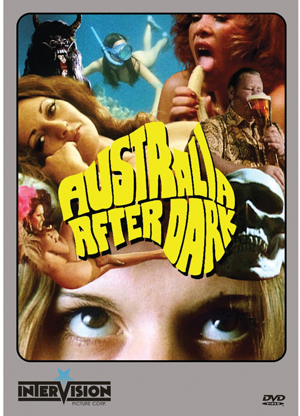Australia After Dark is a slightly misleading title, as very little of it actually takes place at night. Then again the Aussies have always been a hearty, fun-loving people completely unafraid of letting their freak flags fly in the broadest of daylight, and that’s what this documentary is about. In the tradition of the Italian “Mondo” flicks that soared to unexpected popularity on drive-in and grindhouse screens around the world, Australia After Dark is composed of a series of salacious vignettes depicting various alternative lifestyles in the country that gave us Anthony LaPaglia and AC/DC. Since this is an Australian movie there’s also a generous helping of male and female nudity and sexual content. In fact every other segment of the film involves naked women doing things that women typically do while naked. But I’m not complaining here.
Australia After Dark isn’t all about sex and nudity though, just mostly about it. There are short segments devoted to a gallery of death masks made from the faces of executed murderers (including famed Aussie bandit Ned Kelly), a “waterless regatta” that features boat races being held on dry river beds, a world record beer drinker, the Aborigines, UFO sightings, and the continent’s unofficial homosexual capital Perth – where we get to drop in on a gay wedding. But of course after each vignette we return to something sex or female nudity-related like a shop where bikinis are custom-fitted and made, a wizard that practices “white magic” and presides over a ceremony where an array of nude ladies arranged in a circle witness a prospective member being mock crucified and then engaging in deviant sex with their demon mask-wearing leader, a transgender burlesque dancer doing his/her thing, nude women being covered in paint and then rolling across an artist’s blank canvas, and a look inside an exclusive club where weary businessmen go to relax and cavort with mostly naked handmaidens (which, according to the narrator, they later write off as a business expense because it’s tax-deductible).
And that’s not the entire movie.
In fact the copious female nudity is about the only part of Australia After Dark worth watching more than once. It’s not that I didn’t find the other segments of the movie fascinating or even remote interesting at first glance, it’s just that my wavering interest didn’t extend beyond morbid curiosity. It’s difficult to say which segments are real and which, if any, are staged merely to give the movie an extra dose of exploitable elements. It’s true that sex does indeed sell and it was sex that drove Australia cinemagoers to John Lamond’s documentary in droves and made one of the highest grossing films in the history of the land Down Under. The opening and closing credits roll over close-up shots of a nude woman. The movie ends with a woman scuba diving in her birthday suit. Lamond has made a movie that’s very easy on the eyes, despite the occasional presence of unshaven armpits and flapping man dong, but carries little weight as a document of Australian subcultures. There’s no real insight into the documentary’s subjects, no interviews, and few of the people in the movie actually get to talk on camera. Most of the talking is done via Hayes Gordon’s uproarious narration (written by Dennis Gascoigne) which includes such zingers as “You don’t see craftsmanship like that these days” when referring to a rack being used at an S & M party. Only the leering misogyny and homophobia, a product of the times no doubt, struck me as distasteful. But movies like Australia After Dark only succeed by being able to shock, titillate, and offend. On that note, and only that note, does it get the job done. In any case the movie was originally released at a time when Ozploitation was just starting to come into its own. Seek out the great 2008 documentary Not Quite Hollywood for further proof. I highly recommend that film, unlike Australia After Dark.
Shot on 16mm and blown up to 35, the 1.78: 1 widescreen presentation, which was transferred from an uncut print of the film found buried in the basement of an Aussie drive-in, is murky and sports significant amounts of grain but not enough to make it unwatchable (the movie’s glacial pace takes care of that). A robust yet tinny-sounding English Dolby Digital 2.0 mono track aptly compliments the main feature.
The only extra feature is a commentary with director Lamond moderated by Not Quite Hollywood director Mark Hartley. Hartley’s presence is appropriate since it was his amazing documentary that brought about a reenergized interest in Australian exploitation cinema. The filmmaker is bubbling over with unbridled enthusiasm for Lamond’s film even as the director struggles to recall stories from the filming of Australia After Dark. Fortunately Hartley is there to keep things lively and interesting with some trivia and stories of his own and the two enjoy a nice conversational track.
The DVD packaging lists a reel of trailers for other John Lamond films but I didn’t find it on my review disc.
If you’re looking for 82 minutes of solid titillation with absolutely no insight into the fascinating alternative lifestyles being documented you could do far worse than Australia After Dark. Good thing that director John Lamond’s best work still laid ahead once he turned to making fictional features.
Director – John Lamond
Cast – Gina Allen, Count Copernicus
Country of Origin – Australia
Discs – 1
Distributor – Intervision Pictures Corp.
Reviewer – Bobby Morgan

